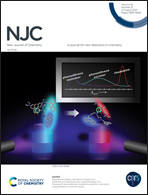Controlled reduction of aromaticity of alkylated polyaromatic compounds by selective oxidation using H2WO4, H3PO4 and H2O2: a route for upgrading heavy oil fractions†
Abstract
Heavy crude oil fractions which form the residues from fractional distillation are a significant proportion of current hydrocarbon reserves. However, processing residues for use as chemicals or fuels is hampered by the high polyaromatic content of this material. Selective reduction of aromaticity by targeted ring opening and the preservation of alkylated chain side groups are key requirements for the upgrading of alkylated polynuclear aromatic hydrocarbons (PAHs) to more easily processed and higher value molecules. In this study, a H2WO4 catalyst combined with H3PO4 and H2O2 oxidant is applied to the selective oxidation of PAHs containing different lengths of substituent alkylated chain, and different numbers of rings in the fused aromatic core. For a model substrate of 2-ethylnaphthalene, using traditional organic solvents, aliphatic carbon was oxidized more readily compared to aromatic carbon. However, it was found that the oxidation to desired products can be specifically controlled as the selectivity is directed by the choice of solvent, with reactions carried out in acetonitrile giving oxidation only in the aromatic region of the molecule. With larger polyaromatic molecules, a biphasic solvent system is used with Aliquat 336 as a phase transfer agent. Even for this more complex reaction system high conversion to the corresponding alkylated ring opened compounds was obtained.



 Please wait while we load your content...
Please wait while we load your content...